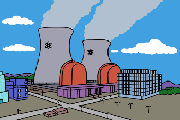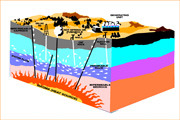Wind isn't just some uncontrollable part of nature that messes up our hair or sucks up Dorothy, Toto and anything else in its way. It can't be trained but it can be put to work. The kinetic energy of wind can be changed into other forms of energy. When a boat uses a sail to push it, that is one form of wind energy at work. Farmers have been using wind energy for years to pump water from wells and turn large stones to grind wheat or corn - just like a water wheel.
 A wind farm
A wind farm
Wind is also used to make electricity. Blowing wind spins the blades on a wind turbine - just like when you blow on a toy pinwheel. When the blades turn, the turbine is operating and electricity is generated. The turbine has a brake, so if the wind blows too hard, the brake can stop the blades from being damaged. Some wind turbines are up to 10 stories high and have blades as long as 50 feet. Wind turbines don't create any pollution but they can be pretty noisy.
Wind has to blow at speeds of 12 to 14 miles per hour to turn the turbines fast enough to create electricity. The turbines usually produce about 50 to 300 kilowatts of electricity each. Kilo means 1,000, so a kilowatt is 1,000 watts. You can light ten 100 watt light bulbs with 1,000 watts. This means a 300 kilowatt wind turbine could light up 3,000 light bulbs that are 100 watts.

Wind turbines are grouped together in what are called wind farms. About 30 percent of the world's electricity is made from wind in California. They have three large wind farms that create enough electricity to supply a city the size of San Francisco with power. Two countries that use a lot of wind energy are Denmark and Germany.
The world's largest wind machine is on the island of Oahu, Hawaii. The windmill has two blades, 400 feet long, on the top of a tower which is 20 stories high.
Have Your Say
Do you have any windy day stories? Comment below if you do!

































